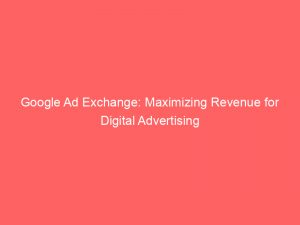In the fast-paced world of online advertising, Google’s Ad Exchange is the gateway to reaching a vast audience and maximizingrevenue. But navigating this virtual marketplace can be a daunting task.
That’s where Google Ad Manager comes in, wielding the power to control user role permissions and custom roles within the Ad Exchange. However, the plot thickens as changes are made to the coveted “Trafficker EMEA” role.
Fear not, for this tale of digital intrigue is just beginning. Join us as we delve into the realm of Google AdExchange, exploring its intricacies, sign-up options, and factors to consider.
Prepare for an adventure of revenue share, optimization, support, and breathtaking performance.
Table of Contents
- google ad exchange
- Ad Exchange User Permissions In Google Ad Manager
- Control Of Ad Exchange Features In The Interface
- Overview Of “Ad Exchange” Permission
- Introducing The “Ad Exchange Manager” User Role
- Changes To Existing User Roles And Custom Roles
- Removal Of “Trafficker EMEA” User Role
- Introduction To Google Ad Exchange (AdX)
- Selecting An AdX Reseller And Key Factors To Consider
google ad exchange
Google Ad Exchange (AdX) is an ad exchange platform owned by Google. It offers ad impressions through real-time bidding and requires an account with Google Ad Manager.
AdX allows publishers to connect with demand partners and maximize their ad revenue. To sign up for AdX, publishers can ask their account manager or partner with a third-party reseller.
When selecting an AdX reseller, it is important to consider factors such as migration to Ad Manager, revenue share, ad revenue optimization, demand partners, support, inventory quality, and performance. AdX can be integrated with Ad Manager to serve ads on remnant inventories, and using header bidding can increase competition and higher bids from AdX.
By optimizing inventories, rules, and leveraging Opportunities and Experiments, publishers can maximize their revenue with AdX. It is worth noting that AdX is the largest demand partner contributing to over 50% of ad revenue.
However, its performance may vary across different browsers. Publishers without a partnership with Google can find a Managed Content Monetization (MCM) partner to monetize their content with advertising.
Connecting with an Account Manager or partnering with a reseller is required to enable Ad Exchange in Ad Manager.
Key Points:
- Google Ad Exchange (AdX) is an ad exchange platform owned by Google, offering ad impressions through real-time bidding.
- AdX allows publishers to connect with demand partners and maximize their ad revenue.
- To sign up for AdX, publishers can ask their account manager or partner with a third-party reseller.
- Factors to consider when selecting an AdX reseller include migration to Ad Manager, revenue share, ad revenue optimization, demand partners, support, inventory quality, and performance.
- AdX can be integrated with Ad Manager to serve ads on remnant inventories and using header bidding can increase competition and higher bids from AdX.
- Publishers can maximize their revenue with AdX by optimizing inventories, rules, leveraging Opportunities and Experiments, but its performance may vary across different browsers.
Sources
https://support.google.com/admanager/answer/6321605?hl=en
https://headerbidding.co/google-ad-exchange-adx/
https://www.publift.com/blog/google-adx-vs-google-adsense
https://support.google.com/admanager/answer/188523?hl=en
Check this out:
💡 Pro Tips:
1. Utilize the “Ad Exchange” permission to access experiments, manage orders, and access interface features and settings in Google Ad Manager.
2. Make sure to link your Ad Exchange account with Ad Manager to serve ads on remnant inventories and maximize revenue potential.
3. Consider partnering with a third-party reseller for Ad Exchange to take advantage of their expertise in migration to Ad Manager, revenue share, ad revenue optimization, demand partners, support, inventory quality, and performance.
4. Implement header bidding to increase competition and higher bids from Ad Exchange, ultimately maximizing revenue potential.
5. Optimize your Ad Exchange inventories, rules, and leverage Opportunities and Experiments in Ad Manager to maximize revenue and performance.
Ad Exchange User Permissions In Google Ad Manager
In Google Ad Manager, the features of Ad Exchange are controlled by user role permissions. This means that only users with the appropriate permissions can access and make changes to the Ad Exchange features.
It is important to note that Ad Exchange user permission must be activated for user roles in order to grant access to these features.
Control Of Ad Exchange Features In The Interface
While Ad Exchange features in Google Ad Manager are controlled by user role permissions, it is important to understand that the Ad Exchange features in the interface are not controlled by Ad Manager permissions. This means that even if a user has the necessary Ad Manager permissions, they may not have access to certain Ad Exchange features in the interface.
Overview Of “Ad Exchange” Permission
The “Ad Exchange” permission is an important user role permission that allows users to view experiments, manage orders, and access various features and settings within the Ad Exchange interface. This permission is necessary for users who need to actively participate in managing and optimizing their ad inventory using Ad Exchange.
Introducing The “Ad Exchange Manager” User Role
The “Ad Exchange manager” user role is specifically designed for active Ad Exchange users who did not have access to Ad Manager prior to a certain date. This user role provides them with the necessary permissions to effectively manage their Ad Exchange account within the Ad Manager interface.
It is aimed at streamlining the management experience for Ad Exchange users.
Changes To Existing User Roles And Custom Roles
With the introduction of Ad Exchange features in Google Ad Manager, existing user roles have been modified to include Ad Exchange permissions. This ensures that users with these roles have the necessary access to utilize Ad Exchange features.
It is important for administrators to review their user roles and make any necessary adjustments.
Administrators should review and modify custom roles as needed.
Removal Of “Trafficker EMEA” User Role
The user role “Trafficker EMEA” is being removed and users who were assigned this role will now be added to a new role called “Trafficker EMEA and Ad Exchange manager.” This change aims to consolidate the user roles and provide users with access to both Ad Manager and Ad Exchange features. Users should take note of this change and familiarize themselves with the new role.
Introduction To Google Ad Exchange (AdX)
Google Ad Exchange, also known as AdX, is an ad exchange platform owned by Google. It offers ad impressions through real-time bidding, allowing advertisers and publishers to buy and sell ad inventory in an automated and efficient manner.
AdX requires an account with Google Ad Manager in order to access its features and functionalities.
Selecting An AdX Reseller And Key Factors To Consider
There are two options to sign up for AdX: either by requesting assistance from an account manager or by partnering with a third-party reseller. When selecting an AdX reseller, there are several key factors to consider.
These factors include:
By carefully considering these factors and selecting the right AdX reseller, publishers can optimize their revenue and make the most of the opportunities provided by the Ad Exchange platform.
Overall, Google Ad Exchange offers publishers a programmatic advertising platform that connects ad inventory buyers and sellers. With the ability to serve ads on remnant inventories and the potential for increased competition and higher bids through header bidding, AdX can help publishers maximize their revenue.
However, it is important to continually optimize inventories, rules, and leverage Opportunities and Experiments within Ad Manager to fully capitalize on AdX’s benefits. Additionally, publishers should keep in mind that while AdSense is a commonly known monetization program, it is not the only option available.
For publishers without a direct partnership with Google, finding a Managed Content Monetization (MCM) partner could be an alternative solution.
In conclusion, the Google Ad Exchange (AdX) platform provides publishers with an opportunity to maximize revenue through automated real-time bidding and various features within Google Ad Manager. By understanding and utilizing the Ad Exchange User Permissions, controlling features in the interface, and selecting the right AdX reseller with key factors in mind, publishers can effectively monetize their digital advertising content and optimize their revenue potential.












